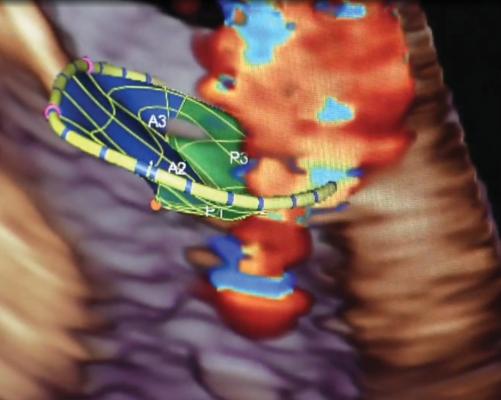
Over the past year, cardiac ultrasound vendors have introduced several new products to speed workflow, improve image quality, offer artificial intelligence to automate some functions, improve valve assessments, and optimize structural heart evaluations and procedural guidance.
GE Healthcare Releases Several New Innovations
At the American College of Cardiology (ACC) 2018 meeting in March, GE Healthcare showed its Imaging Elevated release of its cSound image reconstruction technology. The technology aids imaging quality, workflow and quantification on the Vivid E95 cardiac imaging system. It leverages GPU processing to improve the volume frame rate, which GE refers to as volume max, or Vmax. This allows for nearly triple the frame rate speeds for transesophageal echo (TEE) in a single beat over previous generation systems.
Part of the new release is a new pediatric TEE probe, the 10 MHz 10T, which is about half the size of an adult TEE probe. There is also a new complete all-in-one cardiac imaging probe that was released for the E95, the 4VC. It is about half the size of traditional echo transducers but can image color, 3-D, 4-D, 2-D, Doppler and CW without needing to switch probes.
Watch a video showing these and other vendors' echo advanmcements displayed at ACC.18.
At the 2017 Transcatheter Cardiovascular Therapeutics (TCT) meeting, GE showed its innovative blood speckle imaging (BSI) technology on the E95. It tracks individual blood cells on ultrasound as they flow through the heart on dynamic, 4-D echo. The images show the tracked cells as tiny lines moving through the heart, revealing the blood flow patterns and swirls inside the chambers and through the valves. The lines are color coded to show blood flow velocity. This new way to visualize blood flow is widely expected to enable new diagnostic applications for echo, where patterns in blood flow may show very early signs of valve disease.
The E95 system can image blood flow between 200-400 frames per second (FPS), much faster than the average cardiac ultrasound system, which usually images at 60 FPS. This is enabled by the system’s powerful processing ability, which can process about a DVD worth of data per second.
At the Radiological Society of North America (RSNA) 2017 meeting last November, GE rolled out its first implementation of artificial intelligence (AI) in its ultrasound systems. GE is partnering with Nvidia for AI integration into both computed tomography (CT) and ultrasound. The AI aids the the Vivid E95’s 4-D ultrasound capabilities to speed workflow and automate some features.
AI is also being integrated into GE’s new point-of-care Venue ultrasound system. The user images the patient with a 3-D ultrasound probe and the system’s AI identifies the anatomy being imaged using anatomical landmarks. It then pulls out and displays the optimal views of that anatomy from the dataset. The idea is to save time and speed diagnosis by increasing the reproducibility of the standard views and measurements between various users, regardless of their level of training. GE said it plans to add this AI technology to all its ultrasound platforms.
The GE AI technology is similar to Philips Healthcare’s Anatomical Intelligence used on its Epiq cardiac ultrasound platform. That technology uses 3-D dataset acquisitions of the heart to automatically identify all aspects of the cardiac anatomy and then displays the ideal standard views. It then automatically performs quantification measurements.
Canon Enhances Echo for Structural Heart Evaluation
At ACC.18, Canon launched a more advanced version of its Aplio 900 Cardiovascular system, which was first released in 2017.
The FDA cleared the new version in January 2018. It includes mitral valve (MV) analysis enabling 4-D transthoracic echo (TTE) and transesophageal echo (TEE) for both pediatric and adult patients. It uses 30 seconds of 3-D TEE to auto-derive the standard views of the valve and auto-calculate 44 standard measurements for the MV. This MV analysis takes about 30 seconds to complete. The speed allows it to be used at the patient bedside, cath lab or in the OR, rather than performing these functions post-processing.
Another addition to the system is a new display modality called quad-chamber tracking. It tracks the blood volumes for all four chambers in a single view. It offers both end diastolic and end systolic views of the chambers. See a VIDEO demonstration of this technology.
The Apollo 900 CV was designed with 40 percent fewer keys to simplify workflow and 50 percent lighter than previous Toshiba echo systems. It uses a 256 array, 256 channel driver, while previous systems used a 128 or 64 channel driver. It offers small vessel imaging that can show blood flow in capillary vessels, which is difficult to image on most ultrasound systems. The system also offers 2-D wall motion tracking.
Hitachi Enters Premium Echo Market
At the 2017 American Society of Echocardiography (ASE) meeting, Hitachi unveiled its first premium, dedicated echo system, the Lisendo 880. It offers both 2-D and 3-D imaging. The workflow improvements on the system include the ability to set Doppler cursors to save time, one-touch automated left ventricular volume measurements, and semi-auto right ventricular measurements. It also offers on-board speckle and strain tracking and dual-gated Doppler.
A unique offering on the Lisendo 880 is LVeFlow, which is a simulated contrast echo imaging mode that enhances the left ventricle without the need for bubble contrast.
In addition to the usual echo system functionality, the system offers vector flow mapping (VFM), which can help evaluate the blood flow through the valves and chambers of the heart. VFM is able to quantify the formation of vortices, quantify dissipative energy loss caused by turbulence, aswell as better quantify gradients and regurgitation associated with heart valves and vascular structures.
Watch a VIDEO that shows examples of these technologies.
West Virginia University Heart and Vascular Institute is currently assessing this capability to provide evidence that cardiac multidimensional imaging with assessment of fluid mechanics has important roles in predicting outcomes in transcatheter valve interventions.
At the 2017 TCT meeting, Hitachi launched its MXS2 TEE probe. The 3-D probe uses a single crystal matrix with a 10:1 frequency, and can get a high 60-70 volumes per second.
Siemens Launches Portable Echo, Valve Analysis
At ASE 2017, Siemens introduced its eSie Flow valve analysis software. It has a focus on the mitral valve and flow through the left ventricular outflow tract (LVOT). From a 3-D dataset, the system can automate all the measurements, including proximal isovelocity surface area (PISA) regurgitant volumes.
Siemens Healthineers launched a new portable cardiovascular ultrasound solution at ACC.18 — the Acuson Bonsai. The system was created in partnership with Mindray Medical. The 2-D system provides one-touch automatic optimization of the ultrasound image, eliminating the need for manual optimization on the part of the sonographer. The system also utilizes advanced imaging to optimize specific routine echocardiogram and cardiovascular workflows. The Bonsai is compatible with a set of 14 TTE and TEE transducers.
The system comes loaded with a complete set of user-friendly cardiology applications for fast handling of routine echo exams. This includes a semi-auto ejection fraction measurement app and automatic carotid intima-media thickness measurements to help clinicians acquire measurements in one click.
Last September, the U.S. Food and Drug Administration (FDA) cleared Siemen’s TrueFusion software, which allows integration of ultrasound and angiography to better guide interventional structural heart disease procedures. It is available on the new release 5.0 of the Acuson SC2000 cardiovascular ultrasound system. It addresses the need for fused images, and the new app sends anatomical and functional markers as well as valve models from the Acuson SC2000’s TEE probe to an Artis with Pure angiography system, overlaying ultrasound information with live fluoroscopy images. It allows for seamless integration and co-registration of Artis fluoro and Acuson SC2000 echo.
Additional Content on Recent Cardiac Ultrasound Advances:
Top Echocardiography News and Video From ASE 2017
A Glimpse Into the Future of Cardiac Ultrasound
Advances in Ultrasound Systems
VIDEO: Editor's Choice of Most Innovative New Cardiac Ultrasound Technology at ASE 2017
VIDEO: Editor's Choice of Most Innovative New Cardiac Technology at ACC 2018
VIDEO: Editor's Choice of the Most Innovative New Technologies at TCT 2017


 June 12, 2024
June 12, 2024 









